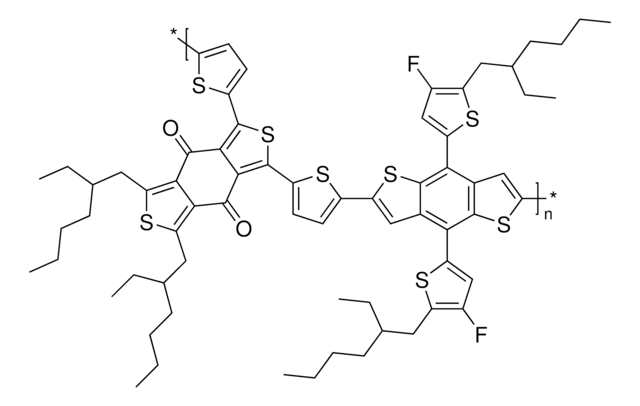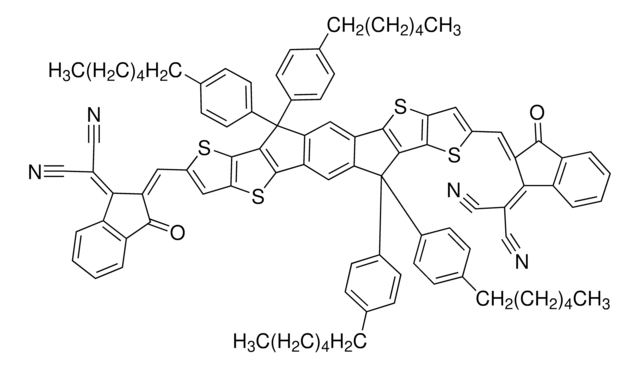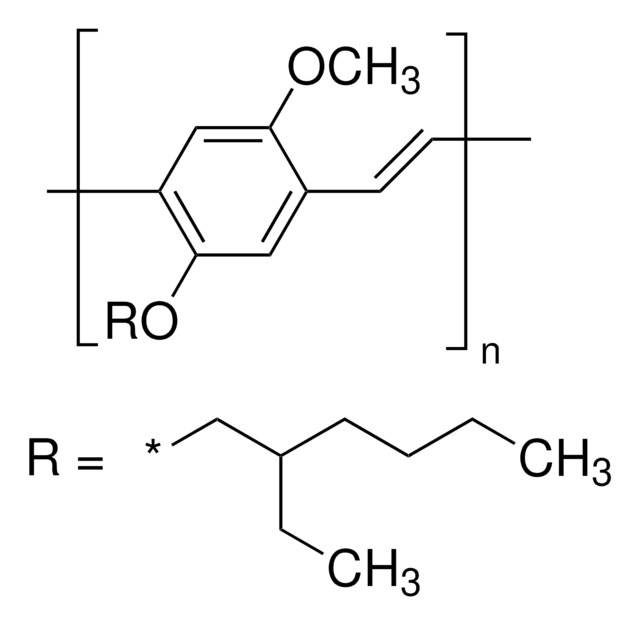906352
PBDB-T-2Cl
Synonym(e):
OS0139, PCE 139, PM 7, Poly[[4,8-bis[5-(2-ethylhexyl)-4-chloro-2-thienyl]benzo[1,2-b:4,5-b′]dithiophene-2,6-diyl]-2,5-thiophenediyl[5,7-bis(2-ethylhexyl)-4,8-dioxo-4H,8H-benzo[1,2-c:4,5-c′]dithiophene-1,3-diyl]-2,5-thiophenediyl]
About This Item
Empfohlene Produkte
Beschreibung
Band gap: 1.95 eV
Solubility:Soluble in 1,2-Dichlorobenzene
Form
particles
Mol-Gew.
50,000-100,000 g/mol by GPC
Farbe
Fine
Löslichkeit
chlorobenzene: soluble
chloroform: soluble
Energie der Orbitale
HOMO -5.52 eV
LUMO -3.57 eV
PDI
2‑4
Anwendung
Polymeric donor material
LUMO=−3.57 eV
HOMO=−5.32 eV
OPV Device Performance :
PBDB-T-2Cl:IT-4F
Voc= 0.86V
Jsc= 21.46 mA/cm2
FF= 0.75
PCE=13.9%
PBDB-T-2Cl (or PM7) is a wide bandgap polymer donor (n-type semiconductor) containing chlorinated thienyl benzodithiophene (BDT-2Cl) used in high performance polymer solar cells (PSCs). PBDB-T-2Cl-based devices exhibit higher open circuit voltage (Voc) than the PBDB-T-2F-based devices, due to lower molecular energy levels of PBDB-T-2Cl, and leading to an outstanding power conversion efficiency of over 14%.
In general, chlorination is more effective than fluorination in downshifting the molecular energy levels and broadening the absorption spectra.
Lagerklassenschlüssel
11 - Combustible Solids
WGK
WGK 3
Flammpunkt (°F)
Not applicable
Flammpunkt (°C)
Not applicable
Hier finden Sie alle aktuellen Versionen:
Analysenzertifikate (COA)
Leider sind derzeit keine COAs für dieses Produkt online verfügbar.
Wenn Sie Hilfe benötigen, wenden Sie sich bitte an Kundensupport
Besitzen Sie dieses Produkt bereits?
In der Dokumentenbibliothek finden Sie die Dokumentation zu den Produkten, die Sie kürzlich erworben haben.
Kunden haben sich ebenfalls angesehen
Artikel
The emerging organic photovoltaic (OPV) technology is very promising for low-cost solar energy production.
The emerging organic photovoltaic (OPV) technology is very promising for low-cost solar energy production. OPV devices can be produced using high-throughput, large-volume printing methods on lightweight and flexible plastic substrates, making them easy to deploy and use in innovative ways.
Professor Chen (Nankai University, China) and his team explain the strategies behind their recent record-breaking organic solar cells, reaching a power conversion efficiency of 17.3%.
Unser Team von Wissenschaftlern verfügt über Erfahrung in allen Forschungsbereichen einschließlich Life Science, Materialwissenschaften, chemischer Synthese, Chromatographie, Analytik und vielen mehr..
Setzen Sie sich mit dem technischen Dienst in Verbindung.

![[6,6]-Phenyl C61 Buttersäuremethylester ≥99%](/deepweb/assets/sigmaaldrich/product/structures/359/221/d990c746-0960-4c69-bf76-fe09b193824d/640/d990c746-0960-4c69-bf76-fe09b193824d.png)
![[6,6]-Phenyl C71 Buttersäuremethylester, Isomerengemisch 99%](/deepweb/assets/sigmaaldrich/product/structures/716/624/9fb9f2f0-ae99-429f-8d3a-b12267976a4d/640/9fb9f2f0-ae99-429f-8d3a-b12267976a4d.png)




![Poly-[(9,9-dioctylfluorenyl-2,7-diyl)-co-bithiophen] 99.9%](/deepweb/assets/sigmaaldrich/product/structures/309/000/8b4a3f54-7765-4aca-96c4-74ce328d455d/640/8b4a3f54-7765-4aca-96c4-74ce328d455d.png)
![Poly-[(9,9-di-n-octylfluorenyl-2,7-diyl)-alt-(benzo[2,1,3]thiadiazol-4,8-diyl)] average Mn ≤25000](/deepweb/assets/sigmaaldrich/product/structures/428/661/1c4ebb98-9d51-48c0-96c7-e556ca425aa4/640/1c4ebb98-9d51-48c0-96c7-e556ca425aa4.png)
